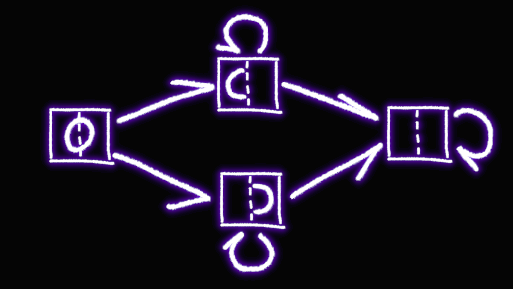CC -or- A Baudrillardian analysis of some missing pigment in my copy of Gödel, Escher, Bach

Printer error. A simple printer error. “ccpies” it read in a place where ink was missing or obstructed by a speck of dust. “ccpies” instead of “copies” it read in a book – in a context – in which any anomaly is forced to carry meaning. I don’t make the rules, I merely obey them.
With perfect 20/20 tunnel-vision, a shovel – a bone – was taken to hand and quickly it slammed upon /through /against* the topmost layer. The original-but-not-really. The first order simulacrum (S1): The heterologous term “copy” had been autologized through the inexact re-creative process of printing. It now contains a copy of its own “c”. A prefrontal cortex explodes before the cryptically corrupted symbol and clicks helplessly into pattern-recognition like child who only knows how to play a single game.
In the maelstrom of patterns it finds a symbol which misleads, which is untrue. Pointing down towards external insights which are not present but foundational**: CC – creative commons: the right to copy overtakes the copy itself. CC – Copycat: The first ever cloned pet. A cat with a fur-pattern wildly different from its genetic equivalent. A cat which, like all second order simulacra (S2), does not resemble its blueprint. And finally: CC – cubic centimetres in medical jargon: Apophenia flips to seizure. Five cc intravenous Lorazepam! Stat!
While this takes its course, truth sinks slowly towards hadal oceanic depths and S3, the obfuscation of a lack of factual correspondence bubbles to the surface. We have lost information, have we not? We act as though we were certain of the original, but the printer-error-function is merely surjective, not bijective. d→c, c→c, o→c, q→c and most worryingly of all: g→c. A genetic nightmare. The biological death knell of an aperiodic crystal. Best case harmless mutation, worst ccase ccancer. Endlessly iterative. ccpies → ccccpies → ccccccccpies…

Alternatively we can imagine an analogous elimination on the opposite side: o→ↄ (b→ↄ p→ↄ) (note that ↄ carries similar implication via the copyleft glyph). Object (o) to corrupted copy (c, ↄ) to absence (∅). The death of meaning. A copy can only create another copy or be annihilated. Lost information cannot be restored by the surjective function. The c occupies its own domain. A symbol freed of its referent, pointing only to itself. S4 is regrettably terminal.

AN: I just scribbled this in my notebook one day and though it was interesting enough to share despite containing little more than references to GEB and Baudrillard. Since I originally wrote it in German, the piece suffers from some translational clumsiness, though aside from two phrases which sadly do not work in English (see asterisks), it should be fine. For those not in the know: GEB is in large part about the ways in which systems can and can’t be made to “talk about themselves” and the problems this causes. It does so stylistically by splitting and un-splitting itself into interwoven, perfunctorily distinct strands, which are all mutually meta-commentaries upon each other. I hope you see how it is interesting to extract a printer-error from such a work and make it “talk about” both itself and the meta-text in which it occurs.
* rasch stößt man auf /durch /gegen ** welche nicht vor- sondern zugrunde liegt